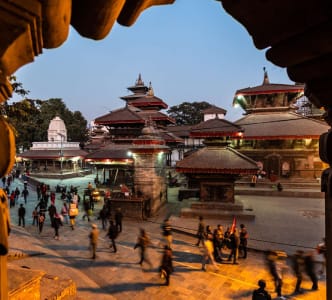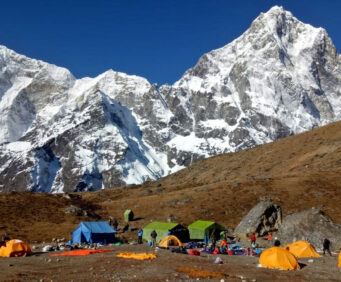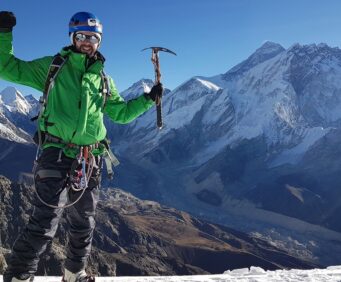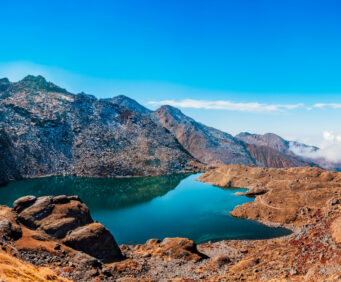
Lobuche Peak Climbing Cost & Itinerary: Complete 2026 Guide to This Spectacular Everest Region Trekking Peak
24th November, 2025 - Posted By: Himalayan AbodeMountaineering enthusiasts dreaming of summiting a Himalayan peak near Everest will find Lobuche Peak an accessible yet thrilling challenge. This comprehensive guide on Lobuche Peak climbing cost & itinerary will prepare you for success in climbing this celebrated trekking peak (6,119 m) in Nepal’s Everest region.
Lobuche Peak offers a mix of technical climbing and trekking, perched among iconic mountains like Everest, Lhotse, and Nuptse. Understanding the full costs, trekking schedule, itinerary details, and climbing difficulty will help you plan properly for your expedition and maximize your chances of a successful summit.
Introduction to Lobuche Peak Climbing
Lobuche Peak is a remarkable mountain with two summits—Lobuche East (6,119 m) and Lobuche West (6,145 m). The East Peak is classified as a trekking peak by the Nepal Mountaineering Association (NMA), while the West Peak demands a full expedition permit due to its technical difficulty. This guide primarily covers Lobuche East climbing, the more popular option for trekkers.
The peak provides a challenging ascent featuring steep snow slopes, glacier traverses, and rocky ridges. The spectacular views of the Everest massif and surrounding peaks serve as your well-earned reward.
Detailed Lobuche Peak Climbing Itinerary
The climb typically spans 16 to 21 days, combining trekking in the Everest region and summit attempts. The itinerary includes acclimatization for altitude and technical climbing preparation.
Day 1-2: Arrival and Kathmandu Sightseeing
Fly into Kathmandu Tribhuvan International Airport. After a briefing with your guiding company, explore UNESCO heritage sites in Kathmandu. Prepare equipment and finalize permits.
Day 3: Lukla Flight and Trek to Phakding (2,610 m)
Fly Lukla, the gateway to Everest, famed for its extreme landing strip. Begin trekking alongside the Dudh Kosi river. The trail is relatively gentle, with views of terraced mountain villages.
Day 4: Trek Phakding to Namche Bazaar (3,440 m)
Enter Sagarmatha National Park, crossing suspension bridges with panoramic Himalayan backgrounds. Namche serves as the main acclimatization and supply hub.
Day 5: Acclimatization Day in Namche Bazaar
Explore viewpoints overlooking Everest, Nuptse, Lhotse, and Ama Dablam mountains. Resting improves oxygen adaptation for higher altitudes.
Day 6: Namche Bazaar to Tengboche (3,860 m)
Ascend to Tengboche, known for its iconic monastery offering a spiritual Himalayan setting along the trekking path.
Day 7: Tengboche to Dingboche (4,360 m)
Trek through alpine meadows to Dingboche, a prime stop for acclimatization.
Day 8: Acclimatization day in Dingboche
Optionally hike to Nagarjun Hill for breathtaking views. This day is crucial for preparing for the summit push.
Day 9: Dingboche to Lobuche (4,910 m)
Move through rocky paths toward the Lobuche village and base camp, where climbing preparations begin.
Day 10-11: Climbing Training at Lobuche Base Camp
Attend training sessions on ice axe use, crampon walking, rope skills essential for the summit assault.
Day 12: Lobuche Base Camp to High Camp (5,900 m)
Climb steep pitches with technical sections, setting camp for summit.
Day 13: Summit Day (6,119 m) and Return to Base Camp
Summit ascent features steep slopes and mixed terrain. Upon reaching the top, enjoy stunning views of Mt. Everest, Lhotse, Makalu, and surrounding giants.
Descend to base camp for rest.
Day 14-17: Return Trek to Lukla and Flight to Kathmandu
Descend through the Khumbu valley retracing the trail to Lukla. Fly back to Kathmandu and conclude the expedition.
Lobuche Peak Climbing Cost Breakdown
Lobuche Peak climbing cost varies depending on itinerary, support needs, and additional trekking included.
Permit Fees
- Trekking Peak Permit: Approximately $500 USD (varies yearly).
- Sagarmatha National Park Entry: About $30 USD.
- TIMS Card: $20 USD for individual trekker, mandatory for Everest region.
Guide and Sherpa Support
- Certified mountaineering guides and Sherpas typically cost $750 – $1,200 USD for the entire climb.
- Sherpa corps provide essential support in camps and technical sections.
Accommodation and Food
- Lodge accommodations en route average $5 to $10 per night; higher altitudes may require tents.
- Meals from $5 to $15 per day depending on location and choice.
Equipment Rental
- Optional mountaineering equipment rental such as crampons, ice axes, harnesses ranges from $150 to $250 USD.
Transportation
- Lukla-Tibet flights average $150-$200 each way.
- Kathmandu to Lukla round-trip flights total about $350 USD.
- Road transportation or transfers within Nepal cost vary.
Additional Costs
- Travel insurance with high-altitude coverage and emergency evacuation is strongly recommended.
- Tips and summit bonuses for guides and Sherpas, generally $300-$500 USD.
Total Estimated Cost
Including all logistics, guided support, permits, and essentials, expect around $2,200 to $3,200 USD per person for a complete Lobuche East Peak climbing package.
Understanding the Climbing Difficulty of Lobuche East Peak
The climb difficulty for Lobuche East Peak is considered high among trekking peaks. It demands technical skills with a mix of ice climbing, rock scrambling, and glacier navigation.
Technical Elements
- Use of fixed ropes on steep ice and snow terrain.
- Negotiating crevasses and icy ridges.
- Exposure to high wind and cold temperatures.
Physical and Altitude Challenges
- Elevation gain from base camp (~5,000m) to summit (6,119m) is steep and taxing.
- Possible altitude sickness symptoms requiring strict acclimatization and hydration.
Mental Fortitude
- The summit push requires stamina, focus, and resilience to weather unpredictability and fatigue.
Essential Preparation for Lobuche Peak Climbing
Physical Training
- Cardiovascular exercises like running, cycling, swimming.
- Strengthening core, legs, and improving balance.
- Prior high-altitude experience is a plus.
Technical Skills Practice
- Ice axe and crampon training.
- Rope handling and climbing safety techniques.
Equipment Checklist
- Double mountaineering boots suitable for crampons.
- High altitude sleeping bag (-20°C rated preferred).
- Insulated jackets, gloves, thermal wear.
- Climbing harness, helmet, belay device.
Best Seasons and Weather for Lobuche Peak Climbing
The optimal months are:
- Spring Season (April – May): Clear skies, stable weather, less snow on routes.
- Autumn Season (September – November): Cool, dry, excellent visibility and calm conditions.
Avoid monsoon and winter seasons due to heavy snowfall, avalanches, and flight cancellations.
Lobuche East Peak Views and Experience
From the summit, climbers witness jaw-dropping views of Everest, Lhotse, Makalu, and the Rongbuk Valley. This vantage point offers a panoramic Everest experience that few trekking peaks can match.
FAQs about Lobuche Peak Climbing
- Q: Do I need prior mountaineering experience?
A: It’s recommended but novice climbers with good fitness and training can attempt with guides. - Q: How long does the climb take?
A: Typically 16 to 21 days including trekking and acclimatization. - Q: What are the health risks?
A: AMS, exposure, dehydration; proper acclimatization is critical.
Recent Posts



